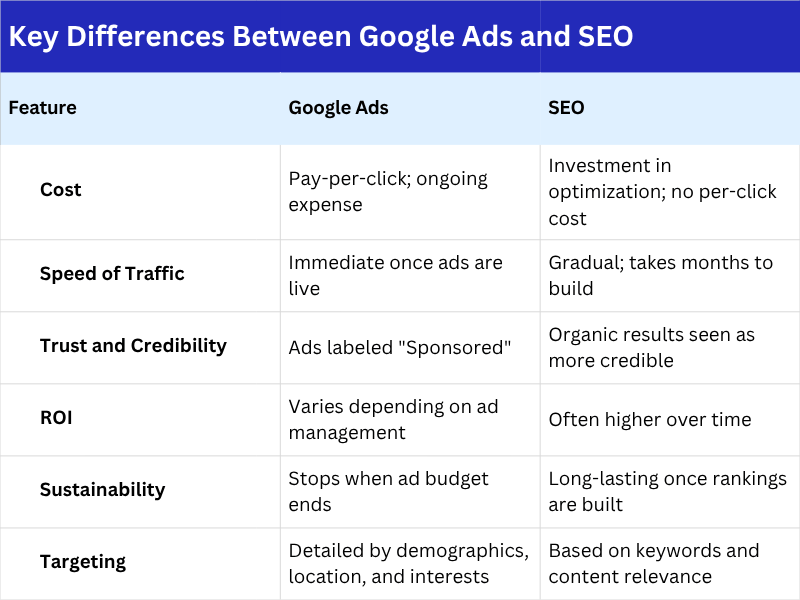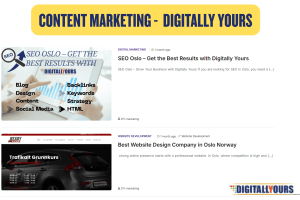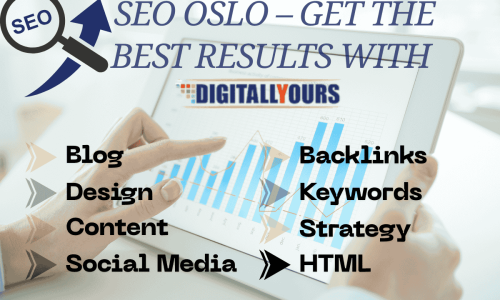- DY-marketing
- 0 Comments
- 335 Views
If you run a small business and want more website traffic, you’ve probably compared Google Ads vs SEO. Both are core strategies in digital marketing, but they serve different purposes depending on your goals, budget, and timeline. This guide breaks down how each works, their pros and cons, and how to combine them for the best results.
What Is Google Ads in the Google Ads vs SEO Debate
Google Ads is a pay-per-click (PPC) platform where businesses bid on keywords to show ads in Google search results and across its partner networks. When someone clicks your ad, you pay a cost per click (CPC) that varies by industry and keyword competition — typically between $0.50 and $12+ per click.
(Source: WordStream)
Google Ads provides instant visibility, especially for competitive keywords, as ads often appear in the top three search positions labeled as “Sponsored.”
Benefits of Google Ads for Small Businesses
-
Immediate positioning at the top of Google search results
-
Targeting by location, demographics, device, and user interests
-
Option to schedule ads by time and day
-
Drive traffic to specific landing pages
-
Conversion tracking and remarketing options for display campaigns
Disadvantages of Google Ads
-
Continuous cost with no lasting organic benefit
-
Ads are marked as paid, which may reduce trust
-
Requires ongoing optimization to stay cost-effective
-
Can become expensive in high-competition niches
-
Demands testing to refine ad copy and keyword strategy
If you’re considering Google Ads as part of your online strategy, check out our Digital Marketing Services for campaign setup and management.
What Is SEO and How It Differs from Google Ads
Search Engine Optimization (SEO) focuses on improving your website’s visibility in organic (unpaid) search results. It includes both on-page factors like content quality, keywords, page speed, and usability, and off-page factors such as backlinks and authority.
SEO doesn’t deliver instant results but builds sustainable growth over time. Once your pages rank, you can attract traffic without paying per click.
Benefits of SEO for Long-Term Growth
-
Long-term visibility in organic search results
-
Higher trust and engagement from users
-
No direct CPC costs — investment goes into site optimization
-
Builds credibility and brand awareness
-
Organic visitors tend to have lower bounce rates
Disadvantages of SEO
-
Results take 3 to 6 months or more to appear
-
Rankings must be maintained through regular updates
-
No immediate ROI
-
Requires continuous technical and content improvements
Learn how our SEO Services can help your business rank higher and gain organic traffic sustainably.
A 2024 BrightEdge study found that organic search drives more than 50% of all website traffic, compared to just 5% from social media. On the other hand, a DemandSage report revealed that Google Ads delivers $2 in revenue for every $1 spent — proving both can be effective depending on how you use them.
Why Combining Google Ads and SEO Is the Smartest Approach
Your decision depends on your business stage and marketing goals:
-
Use Google Ads for instant visibility, seasonal promotions, and testing new markets.
-
Use SEO for long-term traffic growth, credibility, and cost-effective lead generation.
For many small businesses, the ideal solution is to combine both. Google Ads provides quick insights into which keywords perform best, while SEO builds authority and sustainability. Over time, as your organic presence strengthens, your reliance on paid ads can decrease.
You can see how this hybrid approach works in our Web Design Services, where design, SEO, and paid campaigns are integrated for consistent performance.
At Digitally Yours, we help small businesses design growth plans that use both Google Ads and SEO effectively. Ads bring immediate traffic and data, while SEO builds a strong foundation for lasting success.
Many clients start with Ads to identify profitable audiences, then expand with SEO content targeting those same high-converting keywords. This balance ensures growth that’s both fast and sustainable.
Final Thoughts
The Google Ads vs SEO debate isn’t about choosing one or the other. It’s about understanding when and how to use each tool. Google Ads drives fast results, while SEO builds trust and stability over time. Together, they make your online presence more competitive and resilient


